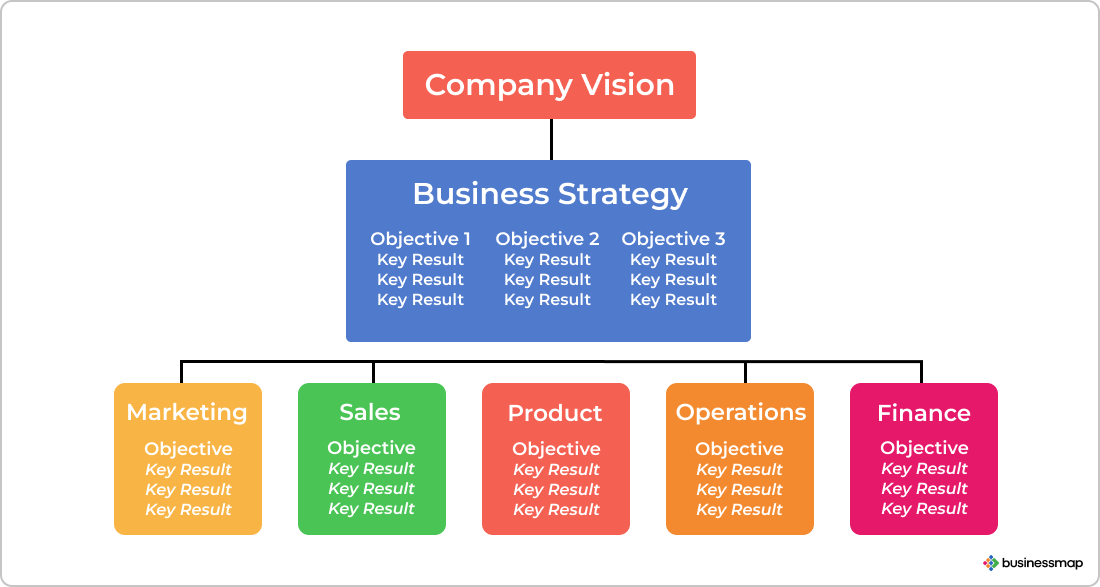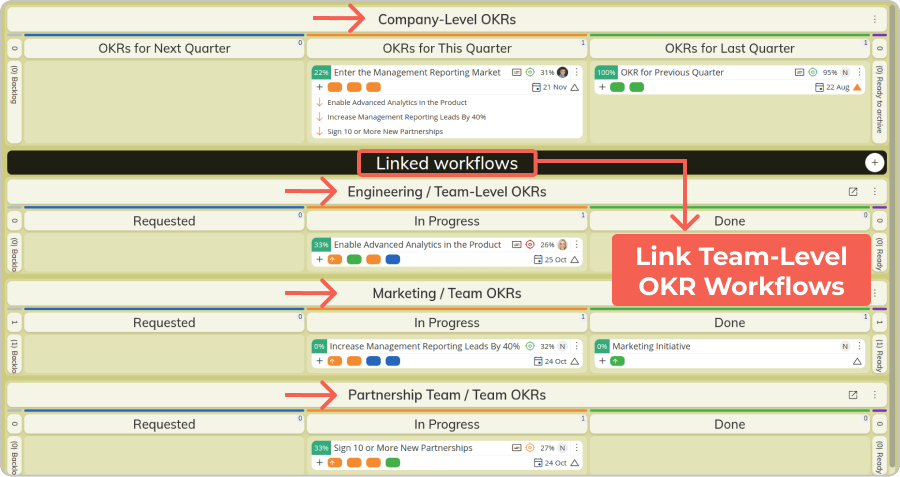As the driving force behind an engineering firm specializing in digital ticketing solutions for public transportation, you're aiming high - to take your business to the top as the leading provider across the country. Picture this: you rally the troops and lay out your ambitious roadmap for growth.
You've shared your dream - dominating the national market for public transport ticketing systems. Great first step! But what comes next? How can you tell if you're on the right path? How do you ensure this mission resonates with your team? How can your initial announcement evolve into genuine motivation?
Tech titans like Google, LinkedIn, and Uber have all leveraged the OKR (Objectives and Key Results) framework to set clear, measurable targets, monitor progress, and turn their grand aspirations into reality.
Let's dive into how you can implement OKRs to work and truly make them sing within your organization.
How to Implement OKRs? The 4 Key Steps
Having a clear vision, getting everyone on board with the direction, and measuring and tracking progress can turn an initial OKR implementation into a true adoption of the framework. Mastering the following four foundational steps to OKR rollout will help you speed up your goal-reaching journey.
- Have a Clear Company Vision
- Create OKRs Collaboratively
- Align with the Vision
- Reflect on Progress
Step 1: Set a Clear Company Vision - OKRs Do Not Replace Strategy
Needless to say, goal management methods can only take you as far as your understanding of their purpose goes. Simply doing something does not mean you do it right and that you will benefit from doing it.
The Objectives and Key Results framework facilitates setting measurable goals and helps you evaluate their outcomes; it's a way to narrow down efforts according to the right priorities. Its purpose is to support your efforts toward reaching your goals which should be aligned with your strategic vision.
But don't forget that OKRs do not replace your strategy. For a successful implementation, you need a wider strategic direction that people are already familiar with. You can then think of the OKRs framework as the driving force that helps you turn strategic goals into continuous wins that move your company forward.
The strength of OKRs is that they enable you to define measurable goals and communicate them across business units. This empowers teams and departments to define further their OKRs, contributing to your company vision.
So, start with your company strategy at the top and allow OKRs to contribute to its execution in a transparent and comprehensive manner. This leads us to the next critical attribute of an OKR implementation.

Step 2: Collaborate when Defining OKRs
The key to a successful OKR implementation is also dependent on collaboration. As a result of collaboration, you ensure that all ideas, priorities, and goals you define are aligned with the company's goals.
A common pitfall with OKRs is taking a top-down approach where top-levelOKRs cascade onto the rest of the organizational levels. Instead, aim to align your OKRs so that when the market requires a shift of priorities, you have the leverage to adapt. Managing a healthy bottom-up and top-down collaboration will ensure that OKRs are not created in isolation and "blindly" pushed on teams.
Collaboration also empowers individual teams or cross-functional groups to devise their own OKRs further, if they will. Their goals can be remotely connected to the management OKRs or not connected at all. What matters is to have those team/departmental-level OKRs synchronized with the bigger company plans, so their progress can propel you to follow your organizational vision.
Step 3: Aim at Transparency and Alignment to the Company Vision
Besides defining clear goals and measurable outcomes while collaborating, you should make the resulting OKRs transparent. Your OKRs should make it possible for everyone to perpetually see how you plan on achieving your strategy, understand the pressing challenges, and know how each team is contributing to the "bigger picture".
Furthermore, clear and company-wide transparent goals will help you enhance your focus on what matters. With such improved visibility, your chances of aligning all work with the set priorities also improve.
"What's more, OKRs were not private benchmarks shared only with managers. They were public knowledge,..You could even see Larry [Page] and Sergey's [Brin] OKRs"
In the Plex: How Google Thinks, Works, and Shapes Our Lives, by Steven Levy
OKR visualization in the real world is attainable through simple OKR templates using spreadsheets, as Google did in 1999. Today, however, this approach can quickly get chaotic, especially when discussing implementing OKRs on a wider scale. To do that, you need a modern-day OKR software solution that clarifies how different OKRs are connected to one another.
Using Businessmap, for instance, you can set goals at a top level, allow teams to create their contributing OKRs, and connect team- to company-level OKRs to create a transparent overview of the progress of every single goal. All of that is available in a single view and is accessible to all contributors.
 Connecting company objectives with team-level goals
Connecting company objectives with team-level goals
Step 4: Reflect on OKRs' Progress
"We do not learn from experience"...we learn from reflecting on experience."
John Dewey, philosopher, author, and notable advocate of the theory of Reflective Thinking
Defining clear and transparent goals is one side of the coin. Monitoring their completion through measurable outcomes and reflecting on the results is equally important to the success of OKRs.
Evaluating results can involve grading OKRs and reviewing them at select intervals. At Google, for instance, OKR reviews are held quarterly, while employees give a progress report to their direct managers six weeks later using a scale system of 0.0 to 1.0 to grade their OKRs.
You can hold your OKR check-ins weekly, monthly, quarterly, or annual as long as it's a regular practice. At Businessmap, we incorporate OKR check-ins into our usual kanban cadences routine. On a weekly basis, we hold Service Delivery meetings where we track our individual teams' workflow performance and team-level OKRs. This way, we ensure that our team goals align with the wider strategic direction.
Some common topics you can tackle while you reflect on during your OKRs review meetings include:
- How are your goals progressing compared to the actual work? Are they on track?
- Are you focusing on the right priorities at the right time?
- What are the lessons learned? What can you improve?
In addition, OKR monitoring is well-adapted in some modern digital OKR software using percentiles or color indicators to reflect each key result's and objective's progress in real time. This way, you can always be aware of the state of reaching your goals and use that data during your OKR cycle meetings.
 Objectives and key results' progress indicators
Objectives and key results' progress indicators
What Is the Best OKR Implementation Practice?
The one-size-fits-all rule does not apply. Here are some ways to implement OKRs based on your company's size, people's responsiveness, and leadership involvement.
- Roll Out OKRs Gradually within a Single Team. Any team can be the pilot team, be it the leadership team, a product, an engineering team, or a growth team. The goal of the pilot team is to implement the methodology on a small scale before passing it on to OKR champions to spread the knowledge across the organization.
- Choose OKR Champions. You could choose a select group of individuals or one from each team and create a cross-functional group of OKR advocates. The group will learn the framework back-to-front and transfer the knowledge to their respective teammates.
- Start with In-depth Training and Coaching. Many organizations and teams decide to begin with leadership and employee training in OKR. Through extensive OKR workshops and personal coaching, you can successfully implement OKR processes and scale the way you manage outcomes across your organization by improving the goal-setting skills of your collaborators.
- Use an Unusual Format to Inspire Adoption. In 2018 the world-renowned producer of TED Talks realized that they needed a way to set and follow common company goals. On their mission to spread the word about OKRs, project manager Rose Kuo came up with the idea to present the OKR framework, making an analogy to The Little Prince's masterpiece. In an inspiring way, Kuo was looking not only to talk about creating goals and setting metrics but rather to envision OKRs as a way to inspire people to dream big and bold. (Source: WhatMatters "OMG: When TED Adopted OKRs")
Build an OKR Culture
Regardless of whether you are running a local business or a large enterprise, OKRs can become your ally in creating organizing principles. It's a process, and like any process, it takes time, dedication, and work. By involving everyone as much as possible, you can foster the habit of thinking about what success really is in your context and, ultimately, shift the mindset from outputs to outcomes.
Implementing OKRs can help you engage people and, most of all, empower them to exceed their reach while keeping them on the same path to the organizational goals.
Try Businessmap Free for 14 days
Iva Krasteva
Content Creator Expert | Agile Practitioner | Kanban Certified
With a background in Intellectual Property, SEO, content writing, and training in Lean, Agile, and Kanban, Iva is an enthusiastic Agile practitioner who embraces collaboration and flexibility every step of the way. Driven by constant learning and knowledge and fascinated by people's creativity.



